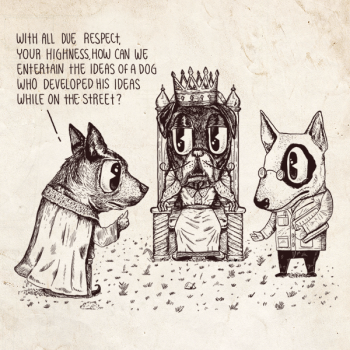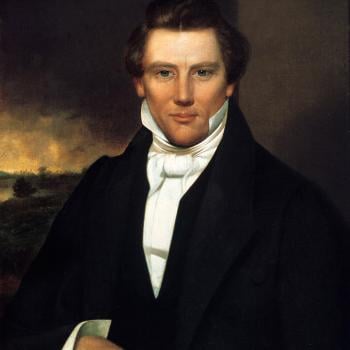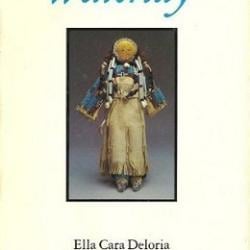Reflections on C. W. Goodyear’s President Garfield: From Radical to Unifier (Simon and Schuster, 2023)
Of all the presidents, James A. Garfield probably held the greatest religious interest for people in my own church circle when I was growing up.

To anyone outside of the Stone-Campbell Restorationist movement, that may seem a surprising statement. Garfield’s presidency lasted only six months, since he was assassinated shortly after taking office. During that time, he accomplished almost nothing other than appointing people to his Cabinet and other federal offices.
And as far as faith goes, Garfield is not necessarily remembered for being unusually pious. He was a churchgoing Protestant, but unlike his predecessor, the devout Methodist Rutherford B. Hayes, he did not ban alcohol in the White House. Unlike one of his successors, William McKinley (another Methodist), he did not hold White House hymn singings.
But for some historically conscious Christians who identify with a wing of the Stone-Campbell Restorationist movement (which includes the Churches of Christ, the Independent Christian Churches, and the Disciples of Christ), Garfield holds a special place, because he was a lifelong Disciple. Not only was he baptized as a Disciple in early adulthood but he also regularly preached in Disciples churches. Several presidents were the sons of Protestant ministers, but Garfield was the only one to serve as a lay evangelist himself. He also served as president (or, as the office was called then, principal) of a Disciples of Christ college – Hiram College in Hiram, Ohio. And he seemed to be deeply invested in the denomination, which was a brand-new religious movement at the time his family joined it. He personally knew one of the denomination’s founders, Alexander Campbell.
So, for Stone-Campbellite Christians interested in both the American presidents and the history of their own religious movement, Garfield held special interest. That was the case for me, both when I was a boy attending a Church of Christ and studying the American presidents, and when I became an adult and embarked on a career as a historian of American religion and politics. I read my first biography of Garfield when I was still in elementary school and then later in life occasionally read whatever I could find on his life, especially if it seemed likely to shed some light on what I eventually began to realize were deep tensions between his political career and his religious faith.
Stone-Campbellites in the mid-nineteenth century generally eschewed politics, because they echoed Anabaptists in believing that the church rather than the political realm would provide the model for social reform. Like Anabaptists, many were pacifist. And on the contentious issue of slavery, the movement’s leading patriarch Alexander Campbell (who was from the western part of Virginia, which was then a slave state), attempted to steer a moderate course by criticizing slavery but devoting even greater criticism to those who tried to bring politics into the church by preaching abolitionism.
Garfield was one of those radical Disciples who preached abolitionism. He was from the strongly antislavery Western Reserve region of Ohio, and he shared the abolitionist sentiments of others in that region. (This was, after all, the region where John Brown spent much of his childhood and where the zealously antislavery Oberlin College was located). Even at an early age, Garfield’s antislavery views were pushing him away from the apolitical sentiments of other Disciples. He chose not to attend the college that Campbell had founded (Bethany College, in what is now Bethany, West Virginia), partly because it was not sufficiently antislavery. Instead, he traveled all the way to Massachusetts to attend Williams College, which was then affiliated with the Congregationalist Church, but which was led by a strong opponent of slavery. Garfield returned to Disciples circles after he graduated and came back to Ohio, where he regularly filled the pulpit of area churches on Sunday, but his opposition to slavery made him restless.
Against the wishes of some of his fellow Disciples, he resigned his faculty and administrative position at Hiram College to run for the Ohio state legislature and remained in politics for the rest of his life. When he entered Congress, he was one of the most radical of the Radical Republicans who demanded immediate abolition. In between stints as a legislator, he also took some time off to serve in the Civil War (which did not accord well with the traditional pacifist views of many Disciples at the time) and became a Union general before continuing his political trajectory.
I already knew most of this history before C. W. Goodyear’s widely acclaimed recent Garfield biography, President Garfield: From Radical to Unifier, was published by Simon and Schuster. But I was eager to read this book, because I hoped that it would offer some clues about Garfield’s motivations and the points where his thinking about the relationship between faith and politics may have changed.

Goodyear, a self-described lapsed Catholic with limited initial familiarity with the Stone-Campbell tradition, did not intend to write a book about Garfield’s religious beliefs or moral character. Instead, he was drawn to a study of Garfield, I think, because of Garfield’s spectacular accomplishments. By the time he died, at the age of 50, he had been a college president, Union army general, Speaker of the House, and president of the United States. He had worked his way up from a canal boat operator in the Ohio backwaters to the highest echelons of national political power.
The main thread running through Goodyear’s biography is Garfield’s intense ambition. He was a man who always seemed to land on his feet whenever he experienced a crisis. His combination of intellectual brilliance, practical intelligence, excellent social skills, and an unusually strong work ethic served him well on his relentless climb up the ladder of professional accomplishment.
But while Garfield’s accomplishments were impressive, I was most interested in what was in his mind and his soul. How did he think of himself in relation to God and others? What I discovered was personally disappointing. I had assumed before reading Goodyear’s book that Garfield’s hatred of slavery and his love of academic studies led him into the most liberal wing of the Disciples, and that his break with his more conservative coreligionists was based on sincere moral conviction and a genuine embrace of liberal theological principles. That may be true, as far as it goes.
But if Goodyear’s portrayal of Garfield is correct, it’s also possible that Garfield may have been less motivated by conviction than by personal ambition. Goodyear’s book was not designed to be a spiritual biography, so Garfield’s faith journey was not a major theme of the book. Nevertheless, the material that it does include offers some tantalizing clues to what may have been going through his mind as he shifted his religious and political perspective not just once but multiple times.
As a young adult, he was motivated by an intense ambition to better himself – and by an equally intense love of winning arguments. Fellow students at Williams College remembered him years later as a star debater. When he returned to Ohio, he was a popular preacher, but he longed to do more – and politics offered that opportunity. He could also be intensely moralistic, especially when it came to issues of slavery and the Union. But above all, he wanted to advance himself, using his undeniable intellectual brilliance. “I . . . am resolved to make a mark in the world,” he wrote at age 18. “I know without egotism that there is some of the slumbering thunder in my soul” (p. 38).
When Garfield was only in his twenties, he began to channel his moral fervor and personal ambition into politics rather than religion. Instead of preaching each Sunday, he instead devoted himself to winning state legislative office and then a US congressional seat. During the war, he took a leave of absence from politics to serve as a Union officer, but then plunged into politics again before the war was over.
Because of his political ambition, his wife, Lucretia, who was a well-read, intellectually minded person in her own right, initially held less interest for him. He was away from home most of the time during their first few years of marriage – a union that Goodyear describes as “loveless,” due to Garfield’s longstanding neglect of his wife and lack of affection for her. The birth of Garfield’s first daughter, whom they nicknamed “Trot,” was not enough to induce him to come home for long. When Lucretia wrote to him to tell him that Trot was learning to crawl, he wrote back, “Do you think she will remember me when she sees me?” (p. 87). Three years later, when Trot died, Garfield came home only for the burial and then immediately caught a train back to Washington, where he could resume his work as a member of Congress – and where he had also been having an extramarital affair with a young widow.
Lucretia, who did not know about the affair, was nevertheless acutely conscious of Garfield’s prolonged absences from home and begged him to visit more often to get to know their surviving child, a young son named Harry. “He is getting to know your picture,” Lucretia wrote. “He would soon learn to love you were you with him” (p. 146).
Garfield may have been touched by the implied rebuke and decided that it was time to confess his extramarital dalliance to Lucretia – perhaps because he knew that it was the right thing to do, but also because rumors of the affair were beginning to circulate, and he was finding it increasingly hard to deny them. But he hardly expressed contrition – a feeling of which he still seemed incapable in the midst of his self-righteousness and intense ambition – and he was taken aback when she didn’t immediately offer forgiveness. “I still believe I am worthy to be loved after all the books are balanced,” he wrote to Lucretia. “I believe after all I had rather be respected than loved if I can’t be both” (p. 146).
But Lucretia soon began to reach out to Garfield with tender affection, and this time, he reciprocated. He moved his wife and children with him to Washington, and developed what Goodyear considers a very close, loving marriage and a new respect for Lucretia that he had never had before. He also became a doting father, enjoying romps with his children around the house before departing for work at the Capitol.
Garfield was an indefatigable worker who was famous for his thorough research before drafting any piece of legislation. Indeed, work consumed nearly every waking minute of his time and became his emotional refuge in the midst of personal grief or family conflict. And it also led to tangible rewards, including an extraordinarily rapid rise through the ranks of Republican party leadership in the US House of Representatives.
Garfield’s intensity did not dissipate during this next phase of his career, in the late 1860s. But his politics quickly changed. When he was first elected to Congress, he was known as an antislavery radical, but his interest in African American civil rights soon began to wane, and he established a new reputation as a centrist in his party – a person who could suggest bring factions together in favor of compromise solutions. It was as though William Lloyd Garrison had become Henry Clay.
This political transition is captured in the subtitle of Goodyear’s book: “From Radical to Unifier.” One of the book’s endorsers, Walter Isaacson, seemed to celebrate this transition when he suggested that it might offer useful lessons for our own politically divided era. “In an era polarized like our own, James Garfield went from being a firebrand to an engineer of compromise and healing.”
That’s one way to look at it: A more mature Garfield found a way to get along with others and became an agent of national “healing” in the aftermath of the Civil War. Another way to look at it – and one that other historians have proposed – is that Garfield, like many other Republicans of the era, decided to exchange the cause of civil rights for the more popular politics of Gilded Age corporate greed. Goodyear withholds judgment and lets his readers determine how they want to interpret Garfield’s career.
He does, though, suggest that there is strong evidence that Garfield accepted a bribe from a railroad company during the Grant administration – an action that nearly destroyed his political career, despite his strenuous efforts to deny it. His denials of the bribe read very much like his denial of an extramarital affair a few years earlier in the sense that they betrayed greater concern for his own self-image than for the morality of the matter. “If there be a citizen of the United States who is willing to believe that, for $329, I have bartered away my good name, these pages are not addressed to him,” Garfield wrote. “I address those who are willing to believe that it is possible for a man to serve the public without personal dishonor” (p. 256). Privately, he agonized over the folly of his actions. “I wonder what my boys will think of it, twenty years hence,” he confided to his diary. “I wonder what I will, if I am alive. . . . It may mark the decline and fall of my political power” (p. 257).
Despite the evidence against him in the scandal (which was known as “Credit Mobilier”), he somehow survived, albeit with a political stain that would never entirely go away. (One Democratic editor nicknamed him the “Artful Dodger”). But it was a corrupt era, and a lot of prominent members of Congress and the presidential Cabinet were guilty of far worse transgressions than taking $329 in unauthorized money from a railroad company that was trying to defraud the government. This was the same time, for instance, when speculators cooperating with the Grant administration plunged the nation into a financial panic by attempting to manipulate the price of gold. Compared to some of his colleagues in Congress who were more-or-less selling offices to the highest bidder, Garfield appeared to be a paragon of moral rectitude. And increasingly, he regained that image, despite never fully living up to it.
But more than anything during this phase of his life, Garfield became known as a person who could build bridges across a badly factionalized party. He was the one who helped orchestrate the deal that put Rutherford B. Hayes into the White House in exchange for the removal of US troops from the South. (It was a contested election, so the ultimate outcome was decided not at the polls but through the negotiations of a special commission that itself was divided along party lines). And in 1880, he received the presidential nomination himself as a dark horse candidate, because none of the frontrunners could gain support outside of their own faction of the party; Garfield was the only one who could appeal to multiple factions.
In an extreme measure of conciliation, Garfield selected a running mate from the faction of the party (the Stalwarts) who were his strongest opponents. There was only one problem: Chester A. Arthur was considered one of the most unqualified, corrupt officeholders in the Republican Party. As head of New York’s customs house, he had control of the most notorious source of political patronage and kickbacks in the corrupt New York Republican party machine that Senator Roscoe Conkling controlled. Most people considered Arthur utterly unprepared to be president – but reformers in the party consoled themselves with the thought that Garfield’s selection of Arthur at least removed him from his source of revenue and paved the way for a potential reform of the system, with Arthur safely exiled to the vice presidency, where he presumably wouldn’t be able to do any more harm.
Even some of Garfield’s supporters began to fear that he was too much of a compromiser, but the new president surprised some Americans by delivering an inaugural address (which he wrote entirely on his own) that called for federal measures to protect Black voting rights – a cause that some Republicans had lost interest in.
However, since Congress was not in session at the moment, Garfield had to devote his time not to legislative proposals but to the distribution of federal appointments, a task that was bound to make him enemies. One of the least mentally stable of those enemies was the disappointed Stalwart Charles Guiteau, who shot the president as he was waiting to board a train and then loudly proclaimed his jubilation that his fellow Stalwart, Chester A. Arthur, was now president.
Garfield actually lingered on for several weeks until an infection from the wound finally killed him. When he died, there was a national outpouring of mourning on a scale that rivaled the grief expressed after Abraham Lincoln’s assassination sixteen years earlier. Garfield was given a magnificent tomb in Cleveland, Ohio, with plenty of speeches celebrating his life.
But in the twentieth century, he was almost entirely forgotten. Goodyear’s biography is the first effort in years to bring his story to the public.
After reading this book, though, I was left with more questions than answers about Garfield’s faith and moral convictions. The first was about Garfield’s own perception of his relationship with God. Among the many extensive quotations from Garfield’s correspondence that this book reproduces, God is hardly ever mentioned – and reflections on Jesus or Christian principles even less so. Nor does the book devote any attention to Garfield’s prayer life. It’s hard for me to assess whether this is because Garfield, who kept a diary and wrote voluminously, really never gave any hint of his dependence on God or whether this reflected the interests of his biographer. But if this really reflects a complete absence of evidence for Garfield’s spiritual life, it raised the question of whether Garfield’s preaching career or his stint as head of a Christian college was merely a platform for his own personal ambition, as Goodyear seems to suggest. Was he morally fervent only when it came to particular causes (such as antislavery) while remaining blind to the depth of his moral lapses? I would love to see the text of Garfield’s sermons from the 1850s, because I imagine they might give a greater clue to his theological views than his personal correspondence does, but perhaps those no longer exist. And absent those sermons, we’re left with evidence that may suggest, at least in Goodyear’s telling of the story, that Garfield’s Christian faith did not play the role in his life that I might have expected from an evangelist.
Before reading this book, I had expected to read that Garfield was such a fervent opponent of slavery that he was willing to distance himself from his own denominational tradition to follow his conscience – and that may well be true. But if it is true, it seems strange that he so quickly moved from the radical wing of the party to the center and that he mostly let his interest in African American civil rights lapse in the process. Perhaps his own political ambition was more important than any sort of moral conviction after all.
But if that’s the case, why did he decide to deliver a stirring call for African American voting rights in his inaugural address, even though it would win him few political plaudits at that point? Perhaps this suggested that he really was capable of courageous moral conviction after all.
And maybe he was. Perhaps he allowed personal ambition to override his sense of morality at times – or perhaps he used moral precepts more as a justification of his political ambition than as a guiding lodestar – but nevertheless, he could still be moved at times by a sense of moral duty, as he may have been when he chose to discontinue his extramarital affair and confess it to his wife instead of continuing to dishonestly deny it or when he chose to speak out on behalf of a cause he believed in, even when it was politically unpopular.
But unfortunately, those moments were not as frequent as I might have hoped.
Perhaps if Garfield had lived he would have turned out to be a stronger advocate of African American civil rights than any other president who served between 1877 and 1900 – just as his inaugural address and the earliest years of his political career suggested. Or perhaps he would have once again become enmired in scandal, as the checkered careers of some of his Cabinet nominees suggested.
In the end, we’ll never know what sort of president Garfield might have been. But I think that Goodyear’s biography offers a historical corrective to those who might want to claim Garfield as a pious exemplar of Stone-Campbellite principles. Though he may have been a Stone-Campbellite preacher and a lifelong Disciple, he was not exactly a model Stone-Campbellite Christian. Nor was he the consistent advocate of African American civil rights that we might have liked, even if he were more sympathetic to the cause than many other Republican politicians of his era were. But he was a fascinating individual – a highly talented man and maybe even a tortured soul who struggled to reconcile his intense love of political power with the moral imperatives of his faith.













